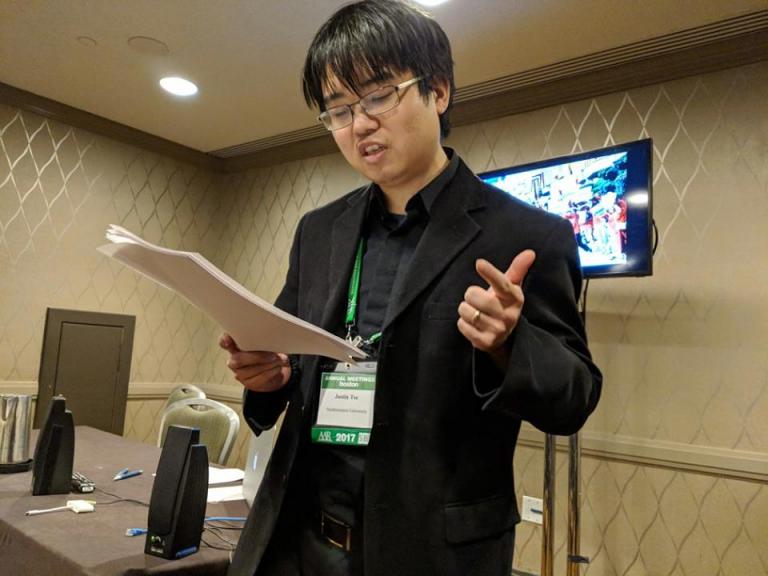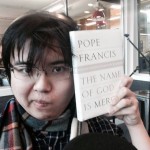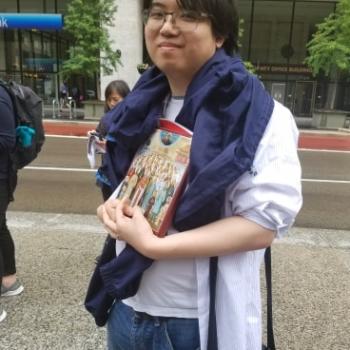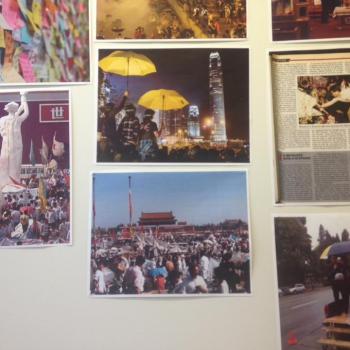
This is the sixth in a series reflecting on what I’ve been doing on the blog. The first, second, third, fourth, and fifth are here.
Two things happened in May that brought me back to reviving the blog after I was stunned into silence by discovering I had been writing about public transference, the bad intellectual habit of seeing the world as a mirror for one’s problems, all along. The first was that I went to see the Chinese dissident artist Ai Weiwei live. He had once had a blog and reminded me that I had one too. The second was that we received a bunch of people into Patheos Catholic as new bloggers, and I had the opportunity to introduce myself to them. I introduced myself via my academic work. I wasn’t sure how not to do so, so I talked about my interest in publics and everyday lives, especially as they related to Cantonese Protestants in my first project and occupy movements in the second.
It was around this time that somebody on Facebook tagged me to do the Album Challenge: post one album per day for ten days without explanation. I did not follow the instructions and posted with all sorts of comments, tracing through ten of my favourite albums the story of my life. In conversation with some friends, I then sought to transform those reflections into blog posts. I only got through about half of them – the first on the trumpet, the second on the violin, the third on jazz, the fourth on the inimitable playing of Glenn Gould, the fifth on Pentecostal worship, and the sixth on Latin chant. I did not manage to get to the point where I could write about my favourite singer ever, Kina Grannis.
As I blogged, I began to reflect on something that I had begun to do soon after my chrismation and have reluctantly been honing as a skill in the Kyivan Church: cantoring. The joke, as far as my parents are concerned, is that I almost cantored my own chrismation. Of course, what really happened is that I was so hungry from fasting all day that I simply sang faster than the kleros. When I moved out to Chicago, the rumor got back quickly to Richmond that on my second week, I had begun to ‘cantor’ at the cathedral, which was not exactly true, but I had indeed sung the tropar and kondak at the English-language service. Curious, my Vancouver bishop asked to hear me cantor when I visited; pretty good, he said afterward.
Cantoring, however, was a skill that I developed very reluctantly. When one is the cantor, one is not only in the kleros, the group of singing leaders in a liturgy, but one is leading them too. There are better singers than me in both Richmond and Chicago, and I would have rather learned slowly from them the art of singing Galician and Kyivan chant. Things didn’t work out that way, though, and the funniest thing is that it had everything to do with my Asian American evangelical past coming to haunt me in Eastern Catholicism.
One of my friends from a community that might broadly identify as Asian American evangelical followed me to the Eastern Catholic church, and if one were to think that I have problems with a weird uniatism in which I am trying to be Orthodox-in-communion-with-Rome but fighting off my old Asian American evangelical habits of contrived authenticity and feigned egalitarianism, then it is safe to say that he has it so much worse, for two reasons. First, Asian American evangelicals tend to sing very loudly, and it does not matter whether they are always in pitch because the loudness of the guitar-bass-drum-keyboard accompaniment tends to drown out any vocal imperfections, even if it is amplified. We have no such luxuries in Eastern Catholic a capella singing; even our smallest faults are audible, and when my friend decided to belt out the chants, he had neither sense of pitch nor balance nor the need for either. The second is that he had an imagination of what Orthodox chant might sound like and mixed them all up promiscuously, making up Greek isons with what he imagined should be a quivering bass line under our four-part harmony. If the congregational singing did not match what was in his head, he sang even louder to drown everyone out. Sometimes, he even moved his hands to conduct.
I was horrified to discover all of this when I returned from Chicago for summer break in Richmond last year in 2017, and for a time, I was not sure what to do except for competing with him in terms of how loud I could sing. But I wanted to preserve my status as a simple member of the kleros learning the real bass line from the Galician chants and did not really want to be seen in any kind of public leadership capacity in the temple. One day, though, I gave up. My friend, bless his heart, was far too overpowering, and in order to hear myself and to sing the actual Galician tones, I channeled my inner Ilya Galadza, the cantor extraordinaire over at St Elias Brampton who waves his hands and jumps as he leads the singing, and began to use my hands to give the congregation a sense of the pitches, when to go up, when to go down, how fast to sing, when to slow down, where the downbeats were. Maybe some of it is fake Wing Chun too; I am far too much of a fan of the Ip Man movies to discount that as a possibility.
The routine stuck. Soon, I was cantoring, in the sense that I was standing up front and leading the singing with my voice and with my hands. Eventually, my friend was told that it might be more helpful for him to adopt a hesychastic posture of silence in the liturgy, and he has remained in that mode for quite some time now, to his great spiritual benefit and to our great peace. However, I also remained in my way of doing things. Even as I went back to Chicago, they still saw me as the cantor in Richmond, and when I visited, I ended up leading Nativity Compline, the full liturgies for Theophany, and Pascha too. In fact, at Theophany, the liturgical scholar Daniel Galadza showed up with an entourage of Orthodox liturgists from various churches to observe how we do things in Richmond. No pressure, I told myself, and proceeded to sing way too quickly until my spiritual father told me to calm down and slow down. Eventually, as our mission in Chicago got started, Julian Hayda and I became the de facto kleros at our temple there as well, which means that in both of my temples, I had to accept that I was beginning to have a liturgical role in the services.
For the first time since high school, I was taking music seriously. I had foresworn a number of concepts and practices since going to college – pitch, timbre, rhythm, harmonic synchronization, ear training, intervals, chording, and so on. I never forgot any of these things. It’s more that they were seldom useful, except whenever I’d get called in my ministry internship days to substitute on the piano or (good heavens) lead praise and worship. Having let the practice slip for some time, there was a bit of a learning curve before I finally got back into musical shape.
Through cantoring, one of the things that I became interested in was how the way we sing and our imagination of what liturgy is might be influenced by our experiences with the public sphere. In some ways, this question was tied to my research. Some of what I do includes asking how the people that I am studying imagine what publics are, as those imaginations often inform the way they build political networks and engage in public practices. Imaginaries are usually themselves informed by other publics, which underscored for me the emphasis on Paulo Freire on the task of conscientization being to develop a consciousness of one’s own consciousness. You want to know what you are influenced by so that you can sort out whether you really are acting with the fullest possible amount of freedom. Some of that work was happening through the prayer that the Kyivan Church was calling us lay people to during the period between Ascension and Pentecost that they called the Mission Days, and I blogged through the first three of them, with topics like ‘A Divine Love That Brings Joy,‘ ‘Liberation from Sin,’ and ‘God is with us – we belong to God.’ I also tied these thoughts back to cantoring with a post on Galician Tone 6 Samohlasny, the vesperal tone that I call the ‘all-purpose tone’ for its usage in describing the risen life in which we share and that we contemplate in our liturgies.
I realized around this time that I was doing something that I should have done years ago when I first began my graduate studies. It wasn’t fair of me to ask my research subjects what they thought concepts like public spheres and civil society were without asking myself, and perhaps even publishing my thoughts while I published theirs too. I had two directions that I felt I was being pulled toward at this point. In the first, I thought I’d rail against the incorporation of postmodern fragmentation into the practice of Christian faith. After discovering that I had come home to Eastern Catholicism, I really felt that the theological currents where I learned to embrace the tensions of being betwixt and between, as it were, really amounted to a lot of nothing. If anything, it just made room for a kind of authoritarianism and an openness to mind control, phenomena that the martyrs and passion-bearers in our church have had a tradition of resisting. It turns out, I thought then, that a kind of embrace of intellectual fragmentation makes way for ideological entrenchment. Better to be promiscuous, I thought.
But I also found myself very taken with the psychoanalytic concept of transference. As I said in yesterday’s post, a colleague of mine at Northwestern had kindly informed me that perhaps the relationship of my work on publics to psychoanalysis lay in the transference. I started a project shortly after that conversation to revive some of my old work on Asian American evangelicals and their engagement with public spheres – this had been the original plan for my second academic project after the Cantonese Protestants, and all my aspirations had been derailed by the Umbrella Movement (just when I thought I was out, they pull me back in, I said, unaware of the irony at the time) – and began by analyzing the public influences on my consciousness. I did so by redecorating my apartment, putting up copious photos and print-outs and turning my apartment closet into a kind of performance art installation with movie posters, album covers, and film stills. I called this phenomenon cinematic transference in drafts that I produced at the time, and I’m happy to share it now on the blog because I don’t know if I’m attached to that terminology now. It is, as they say, a work in progress, and perhaps over the next year – Sam did, after all, give me three years to narrate myself and I am just at the beginning of the third – I’ll write about that.
These two practices – cantoring in my Eastern Catholic home and critically engaging in conscientization about cinematic transference – came together in an unexpected-but-all-too-predictable figure: Andy Warhol. Warhol is everybody’s favourite Eastern Catholic, or he becomes that for most people when they find out he is America’s most famous Eastern Catholic. My student Eugenia Geisel knew this and gave me a book on his philosophy, which could possibly be the philosophical basis for analyzing cinematic transference, but I’ll reserve judgment on that after I digest it. What did begin to happen in my writing was the opening of two new strands. In one thread, I recounted dreams that I had about cantoring the morning after I had them – one about a Latin priest ruining a Divine Liturgy, another about evangelical missionaries doing the same, and a third about taking the liturgical prayers into a hipster evangelical coffeehouse setting. In another strand, I wrote about cinematic transference, like in what I called the ‘pornification’ of American conservative politics, Ariana Grande’s song ‘God Is a Woman,’ and the Polish film Ida.
I began to conceptualize my work here as a kind of intellectual renewal, an unexpected path to chastity in the sense of seeking the integration of my whole person so that I live out of the core of my heart. It led to surprising insights too. Just as I describe the way that my body tends to lead my intellect and heart when I pray with the Byzantine liturgy, I found that this integrative writing began to bleed into practices of everyday life. Unexpectedly, on the eve of my birthday, I suddenly had an urge to do the chores I did as a kid, and it wasn’t until midway into doing them that I began to reflect on how my biological mother raised me to do housework because that is what real men do. I also wrote through my journey from paralysis because of second-guessing everything that I do in my musical activity and writing career and discovered that living in the mirror of the father is what leads to the stunted growth of a kind of intellectual adolescence.
These reflections resulted in three programmatic pieces that perhaps will still be subjected to constant revision, but I think they are less bad than what came before. The first is that as far as my own consciousness is concerned, I admit to being a child of the nineties, and a conservative one at that, and that the tension between my own cinematic transference and intellectual chastity is formed in this crucible. The second is that I discovered that as far as social structures are concerned, I have long been interested in the networks called publics and all of my writing has basically revolved around that concept. The third was the moral dimension of my work: I seek to discern where the immoral process called settler colonialism is happening because the true modern immorality is justification for genocide. Being anti-authoritarian, I discovered, was just the beginning. I really do think that a commitment to radical democratic praxis lies at the moral crux of my intellectual work.
In some ways, I thought that I had arrived and that I’d be able to work with concentration and focus. That did happen much later in the summer, but it took me writing through the crisis over sexual abuse in the Latin Church for me to get there. It turns out that the precondition for focused intellectual work is to know what you are doing and what you are trying to say, even if you are struggling to articulate it. That last part of the journey so far is for tomorrow’s final post in this series, a piece that brings clarity to the progression I realize I have been tracing in terms of what I’ve been trying to accomplish through this blog.
















